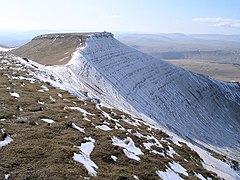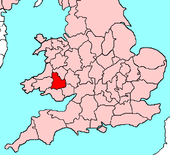Brecknockshire: Difference between revisions
No edit summary |
No edit summary |
||
| Line 9: | Line 9: | ||
|county town=[[Brecon]] | |county town=[[Brecon]] | ||
}} | }} | ||
'''Brecknockshire''' or '''Breconshire''' is a [[Counties of the United Kingdom|county]] in the [[ | '''Brecknockshire''' or '''Breconshire''' is a [[Counties of the United Kingdom|county]] in the mountains of Mid-Wales. | ||
==Geography== | |||
Brecknockshire is an inland county bounded to the north by [[Radnorshire]], to the east by [[Herefordshire]] and [[Monmouthshire]], to the south by Monmouthshire and [[Glamorgan]], and to the west by [[Carmarthenshire]] and [[Cardiganshire]]. The County is predominantly rural and mountainous. The [[Black Mountains]] occupy the southeast of the county, the [[Brecon Beacons]] the central region, [[Fforest Fawr]] the southwest and [[Mynydd Eppynt]] the north. Most of the Brecon Beacons National Park lies within the county. The highest point is Pen-y-Fan at 2,907 ft. The River Wye traces nearly the whole of the northern boundary, and the River Usk flows in an easterly direction through the central valley. Of the many waterfalls in the county, Henrhyd Falls are particularly spectacular. The main towns are [[Brecon]], [[Brynmawr]], [[Builth Wells]], [[Hay-on-Wye]], [[Llanwrtyd Wells]] and [[Ystradgynlais]]. The most important industries are agriculture, forestry and tourism. | |||
{{stub}} | {{stub}} | ||
{{British county}} | {{British county}} | ||
Revision as of 11:51, 18 August 2010
| Brecknockshire Welsh: Sir Frycheiniog United Kingdom | |
 Pen y Fan | |
|---|---|
| Undeb Hedd Llwyddiant (Unity, peace, prosperity) | |

| |
| [Interactive map] | |
| Area: | 743 square miles |
| Population: | Template:Hcspop |
| County town: | Brecon |
| County flower: | Cuckoo flower [1] |
Brecknockshire or Breconshire is a county in the mountains of Mid-Wales.
Geography
Brecknockshire is an inland county bounded to the north by Radnorshire, to the east by Herefordshire and Monmouthshire, to the south by Monmouthshire and Glamorgan, and to the west by Carmarthenshire and Cardiganshire. The County is predominantly rural and mountainous. The Black Mountains occupy the southeast of the county, the Brecon Beacons the central region, Fforest Fawr the southwest and Mynydd Eppynt the north. Most of the Brecon Beacons National Park lies within the county. The highest point is Pen-y-Fan at 2,907 ft. The River Wye traces nearly the whole of the northern boundary, and the River Usk flows in an easterly direction through the central valley. Of the many waterfalls in the county, Henrhyd Falls are particularly spectacular. The main towns are Brecon, Brynmawr, Builth Wells, Hay-on-Wye, Llanwrtyd Wells and Ystradgynlais. The most important industries are agriculture, forestry and tourism.
This county article is a stub: help to improve Wikishire by building it up.
| Counties of the United Kingdom |
|---|
|
Aberdeen • Anglesey • Angus • Antrim • Argyll • Armagh • Ayr • Banff • Bedford • Berks • Berwick • Brecknock • Buckingham • Bute • Caernarfon • Caithness • Cambridge • Cardigan • Carmarthen • Chester • Clackmannan • Cornwall • Cromarty • Cumberland • Denbigh • Derby • Devon • Dorset • Down • Dumfries • Dunbarton • Durham • East Lothian • Essex • Fermanagh • Fife • Flint • Glamorgan • Gloucester • Hants • Hereford • Hertford • Huntingdon • Inverness • Kent • Kincardine • Kinross • Kirkcudbright • Lanark • Lancaster • Leicester • Lincoln • Londonderry • Merioneth • Middlesex • Midlothian • Monmouth • Montgomery • Moray • Nairn • Norfolk • Northampton • Northumberland • Nottingham • Orkney • Oxford • Peebles • Pembroke • Perth • Radnor • Renfrew • Ross • Roxburgh • Rutland • Selkirk • Shetland • Salop • Somerset • Stafford • Stirling • Suffolk • Surrey • Sussex • Sutherland • Tyrone • Warwick • West Lothian • Westmorland • Wigtown • Wilts • Worcester • York |